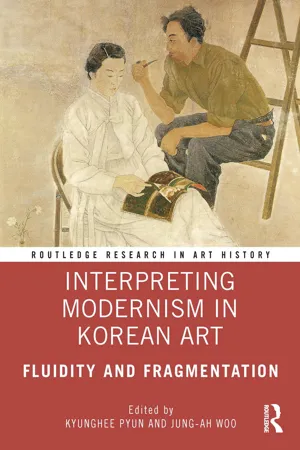
Interpreting Modernism in Korean Art
Fluidity and Fragmentation
- 216 pages
- English
- ePUB (mobile friendly)
- Available on iOS & Android
Interpreting Modernism in Korean Art
Fluidity and Fragmentation
About this book
This book examines the development of national emblems, photographic portraiture, oil painting, world expositions, modern spaces for art exhibitions, university programs of visual arts, and other agencies of modern art in Korea.
With few books on modern art in Korea available in English, this book is an authoritative volume on the topic and provides a comparative perspective on Asian modernism including Japan, China, and India. In turn, these essays also shed a light on Asian reception of and response to the Orientalism and exoticism popular in Europe and North America in the early twentieth century.
The book will be of interest to scholars working in art history, the history of Asia, Asian studies, colonialism, nationalism, and cultural identity.
Frequently asked questions
- Essential is ideal for learners and professionals who enjoy exploring a wide range of subjects. Access the Essential Library with 800,000+ trusted titles and best-sellers across business, personal growth, and the humanities. Includes unlimited reading time and Standard Read Aloud voice.
- Complete: Perfect for advanced learners and researchers needing full, unrestricted access. Unlock 1.4M+ books across hundreds of subjects, including academic and specialized titles. The Complete Plan also includes advanced features like Premium Read Aloud and Research Assistant.
Please note we cannot support devices running on iOS 13 and Android 7 or earlier. Learn more about using the app.
Information
Part I
Korean Modernity and Modernism
2 Korean Art in the Historiography of Multiple Modernisms
Modernism in Korean Art in Multiple Modernisms
Historiography of Geundae and Hyeondae: From Modern to Contemporary
Table of contents
- Cover
- Half Title
- Series Page
- Title Page
- Copyright Page
- Table of Contents
- List of Illustrations
- Contributors
- Acknowledgments
- Introduction
- PART I Korean Modernity and Modernism
- PART II Inventing a Modern Nation: Visual Culture at the Turn of the Century
- PART III Visualizing Colonial Modernities
- PART IV Cultural Consumption and Modernism
- PART V Modernism as Ideology: Revision and Appropriation
- Epilogue
- Selected Bibliography
- Glossary
- Index